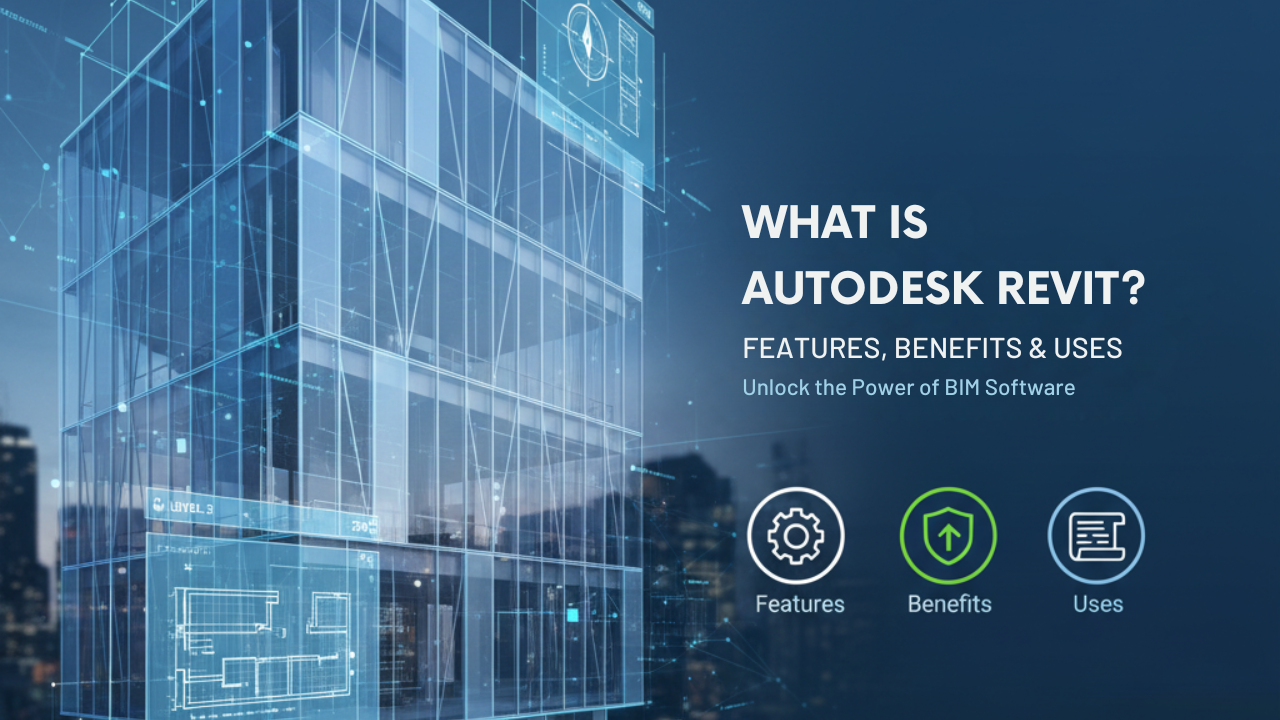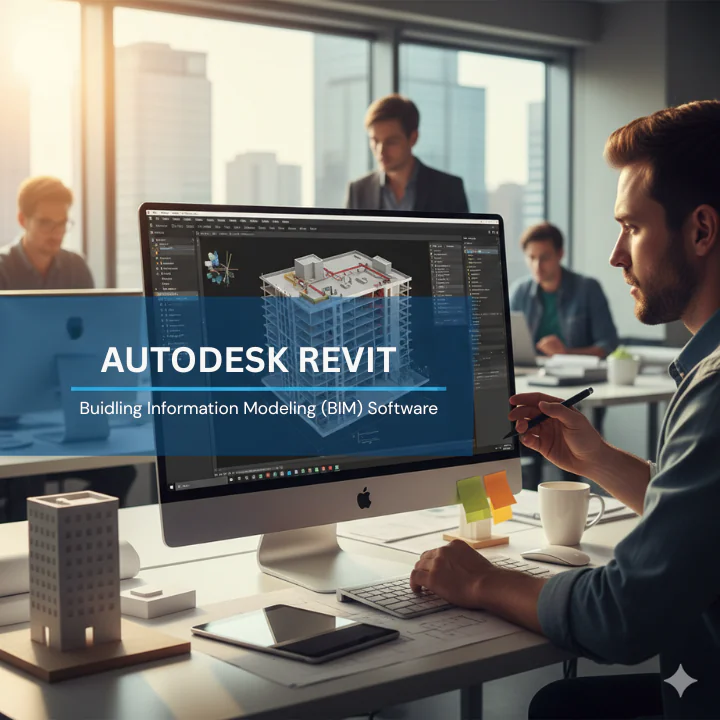What is Autodesk Revit? Features, Benefits & Uses

Do you have any idea how modern architects and engineers build complex buildings with precision? Autodesk Revit is the best Building Information Modeling software that transforms design in the AEC (Architecture, Engineering, and Construction) industry. Revit is different from traditional methods. It lets you create both 2D and 3D models. You can add accurate details and documentation. It also allows for real-time collaboration.
In this guide, we walk you through what Revit is, the differences between AutoCAD and Revit, when to use Revit, highlight new and key features, discuss Revit versions, and the benefits of using the software. Whether just thinking of starting or already using Revit software, this article helps explore everything about the software.
What is Autodesk Revit?
Autodesk Revit is the top Building Information Modeling (BIM) software that helps professionals in the Architecture, Engineering, and Construction to create both 2D and 3D models. The software provides a complete platform to build, design, document, visualize, and collaborate on projects. Revit helps users to access essential project information, including materials, schedules, dimensions, and costs, allowing for the creation of data-rich 3D models, comprehensive documentation, and realistic visualizations.
With advanced features like automation, sustainable design tools, and cloud-based workflows, Revit is a versatile tool. It integrates well with other Autodesk products and works for projects of all sizes. Its multipurpose and collaborative capabilities make Revit software one of the trusted solutions in the AEC industry.
Autodesk offers two primary editions in every release: Revit and Revit LT. Let’s know their core differences in features:
Features | Revit | Revit LT |
Main Purpose | Complete BIM solution for the AEC industry’s large and complex projects | Simplified version of Revit, focuses on smaller projects |
Collaboration Capabilities | Support worksharing for multi-user workflows, linked models, shared coordinates, and more | No worksharing, limited collaboration |
File Compatibility | Support for linking Revit files, copying elements from links with flexibility | Support for modifying Revit files, but can’t copy elements from linked files |
Cost / Licensing | Higher costs for advanced tools | Lower costs with limited functionalities |
What is the Difference Between AutoCAD and Revit?
AutoCAD and Revit are both Autodesk software, but they are different in terms of working purposes. These are:
- Autodesk AutoCAD: AutoCAD is a computer-aided design tool for creating traditional 2D drafts and 3D model designs. People use it in fields like architecture, manufacturing, and engineering. This AutoCAD software is best for precise line-based drawings.
- Autodesk Revit: Revit is a software for building information modeling that focuses on 3D models and design for the AEC industry. It allows users to collaborate with other professionals in a centralized dashboard and provide data-enriched 2D and 3D modeling.
Here’s the short comparison between AutoCAD vs Revit:
Features | AutoCAD | Revit |
Types of Software | Computer-Aided Design (CAD) for 2D drafting and 3D modeling | Building Information Modeling (BIM) software for 2D and 3D modeling |
Used for | General drafting for architecture, engineering, and manufacturing | Specially built for architecture, engineering, and construction (AEC) projects |
Design Method | Line-based drawings (2D) and basic 3D models | Perametric, data-rich 3D models |
Collaboration process | Limited real-time collaboration, files shared manually | Centralized model with real-time collaboration and updates |
Integration | Integrated with various CAD formats, including DWG, DXF, and more | Integrated with other Autodesk tools and cloud workflows |
Who Uses Autodesk Revit?
Many professionals use Autodesk Revit for creating, designing, visualizing, and delivering projects.
- Structural engineers
- Architects
- MEP (mechanical, electrical, and plumbing) engineers
- Civil engineers
- Construction professionals
- Computational designers and others.
Autodesk Revit All Versions Explained
Every year, Autodesk releases new versions with updated features and capabilities. Here we briefly introduce some important Revit versions that you can pick in 2025:
- Autodesk Revit 2022 focuses on improving productivity with features like rebar improvements, tapered walls, and better documentation tools. It supports multiple file formats with expanded interoperability.
- Autodesk Revit 2023 improves performance with better interoperability features, including linked models and cloud-texture paths. It also enhances scheduling and family or group behaviors with documentation.
- Autodesk Revit 2024 includes major upgrades with Simplify Topography, Visual Styles in Type Preview, Dark Theme, and improved site tools. It assists users in creating a model with precision.
- Autodesk Revit 2025 upgrades its features and capabilities by introducing various improvements. It includes the Revit Home interface by enhancing insights and cloud-enabled access, Dynamo integration, expanded toposolid tools, and more for better modeling creation.
Why You Should Use Autodesk Revit?
Professionals have many reasons to use Autodesk Revit. It offers increased collaboration, improved design and documentation, and more capabilities to improve workflow. Here are the reasons:
Enhanced Collaboration
Revit has enhanced collaboration benefits to work where architects, engineers, and construction professionals work on the same model. This software provides real-time updates; you will get instant notifications when any team member changes the model. Also, Revit reduces errors and improves communication while working on a project.
Greater Design and Documentation
Autodesk Revit has parametric modeling that maintains relationships across all project elements. It allows users to change a part of a model, update related components, and save time on repeated tasks. With it, you can produce 2D drawings and documentation from 3D models and simplify the design-to-documentation system.
Generate and Develop Your Design
Revit allows collaboration among architects, engineers, and construction professionals to build efficient, better, and sustainable structures. It helps to simplify workflows with fewer errors and assists in completing tasks using shortcut methods.
Deliver Better Results
Autodesk Revit has included powerful analysis tools that combine multiple datasets and file types, delivering better results for professionals. Using Revit software can enhance the confidence of architects and engineers in their design processes.
Key Features of Autodesk Revit
Autodesk Revit offers several key features that enhance the efficiency of architects, engineers, and construction professionals. Below are some notable features:
Program Interoperability
Autodesk Revit exports and links with various BIM and CAD file formats. This version includes DWG, IFC, 3DM, STEP, OBJ, SKP, and more. Program operability is necessary to increase collaboration among team members working on different tools and software. It helps AEC professionals share information without any compatibility issues. Moreover, operability keeps everyone on the same page, reduces miscommunication, and simplifies workflow.
Twinmotion for Revit
Now, you can utilize Twinmotion directly from Revit to turn your design into reality. This great feature allows you to create intuitive scenes, animations, and more. Twinmotion helps sync design data and provides users with a creator environment to produce wonderful designs.
Effective Documentation
Revit has an effective documentation capability, allowing users to easily create sheets and include drawings. Therefore, Revit provides customizable title blocks and document revisions and ensures that the project information is correctly recorded and accessible. Using Revit, users maintain projects in an organized way and comply with project standards and requirements. Autodesk Revit minimizes time spent on manual documentation. Rather, users can focus on discovering an intuitive design.
Efficient Work Sharing
Revit provides a centralized shared model to the project team members. In this shared model, each member can work on their assigned task and make changes to their project part in real-time. It helps to get better results with an efficient work-sharing process and reduces conflicts among team members. This work-sharing process simplifies complex projects and updates information for every team member.
Multidisciplinary Toolsets
Autodesk Revit has a multidisciplinary toolset where multiple professionals can work on a project. Architectural design, Structural engineering, MEP engineering, Construction developers, and others are working with Revit’s multi-disciplinary tools. These tools assist in designing and documenting projects, reduce rework time, and increase collaboration.
Enhanced Performance
Automating repetitive tasks, designing automation, and streamlining workflow increase Revit’s productivity. Its many effective features, such as clash detection, automated scheduling, and quantity takeoffs, mitigate manual work and eliminate errors. Revit allows scripting and custom add-ins to enhance productivity and achieve better project results.
What are the New Features of Revit 2025?
Autodesk Revit 2025 has included multiple new features to enhance efficiency. This version is impactful for the AEC industry.
New Revit Home
Revit 2025 introduces a new Revit Home, which gives you easy access to your cloud database. This latest Revit Home provides a modern and simple homepage where you can find models and versions with fewer clicks.
Dark Theme
Autodesk Revit 2025 includes a Dark Theme with schedules and panel schedules that do not affect your eyes when you turn it on. Activating the Dark Theme converts it to the general color, keeping readability while using it.
Diverse Toposolids
If you are a user of Revit, you know that earlier versions were not seen as a System Family. This was due to their different features and options. Revit 2024 was introduced as a new System Family, whereas Revit 2025 includes diverse topo solids tools like Excavate tools, Simplify Toposolid, Toposolid by Face, and Toposolid Smooth Shading.
Batch Feature for Materials
In the previous Revit version, the user could adjust only one Material Browser. On the other hand, Autodesk Revit has a new batch feature that allows you to select multiple Material Browser add-to libraries or delete them at once.
Dynamo for Revit
Revit 2025 has included Dynamo, which contains a variety of new elements to streamline a project’s workflow. With Dynamo for Revit, users can easily work with Revit geometry, linked models, and so on. Therefore, creating topography with the new toposolid nodes is effortless with Revit.
What Are the Benefits of Using Revit Software?
Autodesk Revit is an essential software for meeting the rising needs of the AEC industry. Having good skills in Revit, you can secure a better job position, manage projects effectively, and more. Look at the benefits:
Better Coordination
Revit has a cloud-based platform with greater team collaboration facilities to work on the same model. This way, everyone can access the latest information. Revit’s shared model enables error reduction and notifies members immediately if any changes occur. Also, Revit has a clash detection feature that finds and fixes conflicts during construction. It helps with issues between different building systems, like plumbing and HVAC, and also helps reduce costs for rework.
Complete Documentation
Autodesk Revit is best for creating perfect documentation of a project. It helps engineers and architects to create 3D models with realistic forms. Also, Revit automatically produces first-class 2D drawings and documentation of those 3D models. However, this automation feature in Revit saves time and improves the consistency and accuracy of the project.
Focus on Sustainable Design and Analysis
In the AEC industry, creating sustainable design and analysis is a rising and essential concern nowadays. Autodesk Revit has always focused on sustainable building infrastructure. It has built-in analysis tools to create green building infrastructure and help designers improve buildings’ environmental impacts.
Effective Project Management
It’s very important to manage projects carefully with proper planning and resource distribution. Revit has all the benefits of project management with its various tools for cost estimation, scheduling, and more. If any changes are made to the project, Revit updates the project information automatically and calculates costs to provide real insights into the project budget and timeline. Having Revit, users can make the right decision in this situation and use resources properly to control the project efficiently.
Final Thoughts
In this article, we presented detailed information about Autodesk Revit, including its features, benefits and uses. If you work in the Architecture, Engineering, and Construction industry or any other related field and are looking for a reliable and efficient tool for designing 2D and 3D models for architectural, building infrastructure, and construction projects, consider using Autodesk Revit to do it all. Share your experience with Autodesk Revit in the comment section below, or contact us for any sort of assistance.
FAQs:
1. What is the Full Form of Revit?
Revit represents the word “revise instantly”. This highlights the capability for designing 2D and 3D models of buildings and infrastructures. With it, you can revise building designs quickly.
2. What is Autodesk Revit?
Revit is a BIM or Building Information Modeling software to produce 3D models of buildings and infrastructure on a project. It allows users to generate, edit, and review 3D models.
3. Who Uses Revit?
Autodesk Revit users are professionals like architects, engineers, construction professionals, project managers, MEP engineers, computational designers, and so on.
4. Why is Revit Essential for Users?
Revit is essential for users to enhance collaboration, design accuracy, and documentation. It helps AEC professionals generate 3D models with clear visualization and analysis.
5. How Many Types of Revit are Available?
There are various types of Revit software available; these are:
- Revit: Full-featured BIM software
- Revit LT: Core features with limited functionality for individual and smaller projects.
- Revit for MEP: Better for mechanical, electrical, and plumbing systems to create design and documentation.
- Revit for Structure: built for structural analysis and design.
6. Why Do Engineers and Architects Learn Revit?
Engineers and Architects need to learn Revit to create designs with accuracy, improve collaboration, and handle complex projects efficiently. In the growing industrialization of the world, being a Revit expert is considered a valuable skill for professionals to create high-quality design and documentation.




